Snow Report for Brighton Utah: Top Live Resources (2025)
Where to find the most accurate and up-to-date snow report for Brighton, Utah? We compare the top 12 resources for live conditions, forecasts, and canyon travel.
Finding an accurate, up-to-the-minute snow report for Brighton, Utah, is the first step to a great day on the mountain. Instead of checking multiple apps, a reliable system combines live road data from sources like UDOT, official resort lift status, and expert weather forecasts. This guide compares the best resources to help you build a go-to checklist for current conditions, storm totals, and canyon travel times.
What are the best resources for a Brighton snow report?
The most effective way to understand current conditions is by layering information from several specialized sources. No single website answers every question, from "How much new snow is there?" to "Is the canyon road restricted?" Below are the top-tier resources, each serving a specific purpose for your trip planning.
1. Wasatch Travel Helper
Wasatch Travel Helper is an all-in-one dashboard designed for canyon travelers, making it the ideal first stop before heading to Brighton. It consolidates live travel times, UDOT road alerts, parking status, and key weather and avalanche data into a single, easy-to-read view. It excels at answering the critical question: "What do I need to know to get to the resort safely and efficiently right now?"
Key Features & How to Use It
- Live Traffic & Road Conditions: It pulls real-time data to show you current drive times and whether traction laws are in effect. Check this before you leave home to avoid delays. For more on this, see our guide to UDOT road conditions in Utah.
- Consolidated Data Hub: By combining NOAA weather, live cameras, and avalanche forecasts, it provides a complete operational picture without needing to open multiple tabs.
- Actionable Local Tip: Use the live camera feeds to visually confirm road conditions and see how full the Brighton parking lot is. This is the best way to avoid being turned away on a powder day.
Website: https://wasatchroads.com
2. Brighton Resort (Official Site)
For the most authoritative information on what's happening on the mountain, always check the source. The official Brighton Resort website provides the ground truth on lift and trail status, grooming reports, and any operational changes. It's the only place to get a guaranteed-accurate answer to "Which lifts and runs are open right now?"
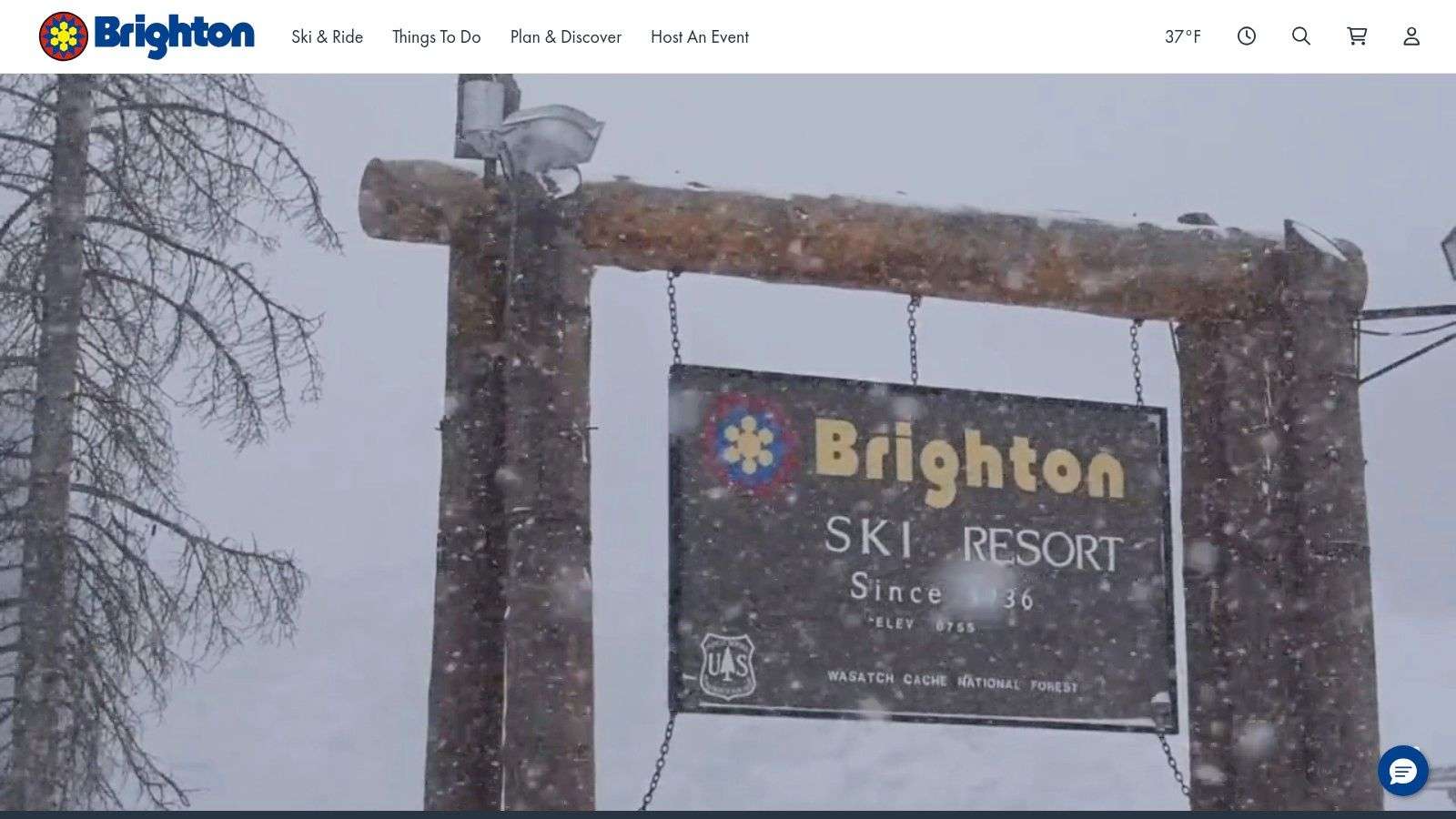
Key Features & How to Use It
- Real-Time Operations: The conditions hub is updated live by resort staff, making it the most reliable source for lift status (e.g., wind holds) and open terrain.
- Parking & Logistics: On busy days, the site provides crucial updates on parking lot capacity.
- Actionable Local Tip: Before leaving, check the lift status page first. A quick glance can confirm if your favorite chairlift is running, saving you a disappointing trip. It's also a great way to monitor the road status for Big Cottonwood Canyon.
Website: https://www.brightonresort.com/
3. Ski Utah – Brighton Snow Report
Ski Utah offers a standardized and highly scannable snow report that is perfect for comparing conditions across the state. It cleanly presents the most important numbers: 24/48-hour snowfall, base depth, and season-to-date totals. This is the best tool for answering the question, "How does Brighton's new snow stack up against other resorts?"
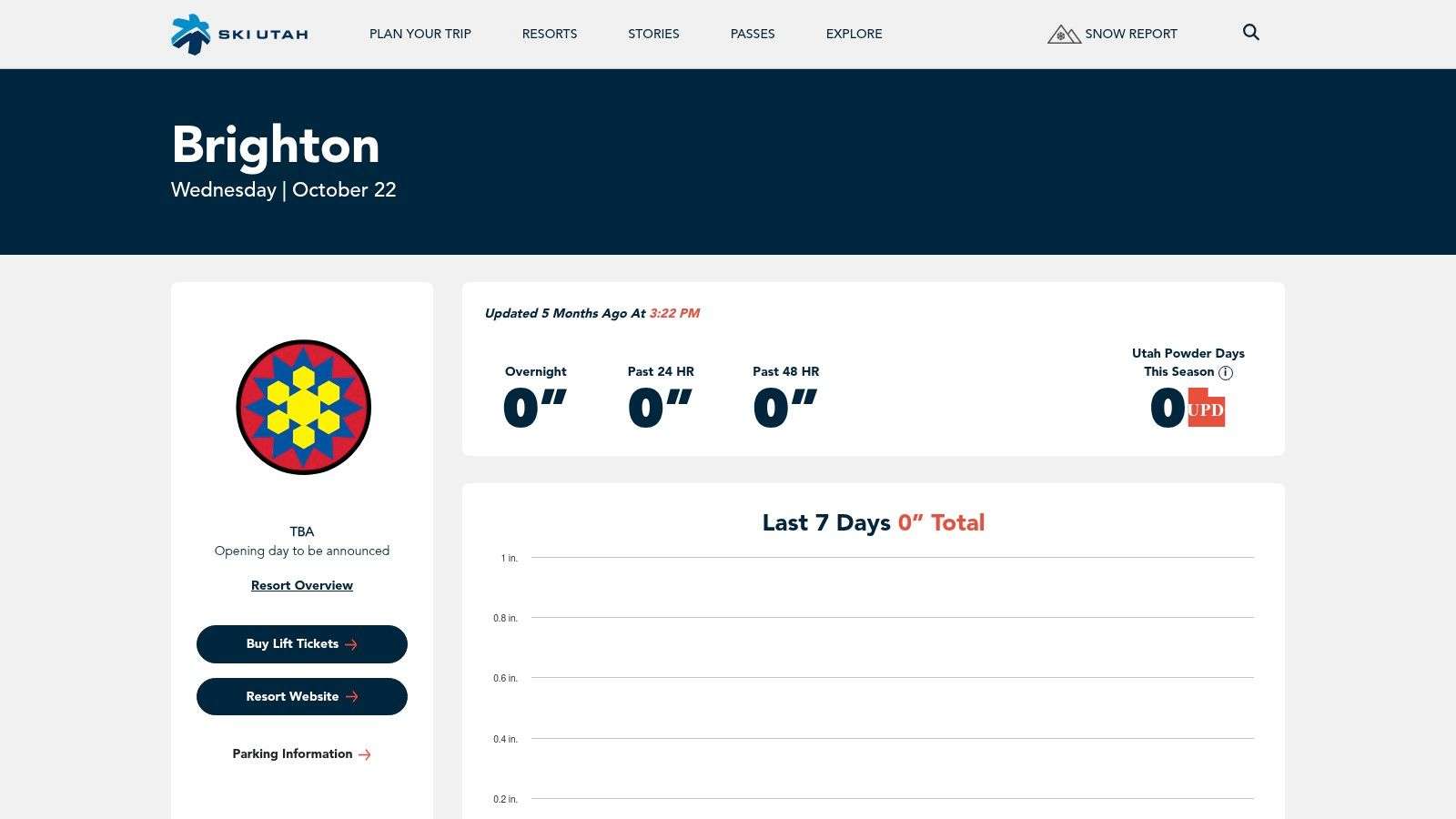
Key Features & How to Use It
- Easy Comparison: The consistent layout across all Utah resort pages makes it simple to see who got the most snow from a recent storm.
- At-a-Glance Data: Quickly find the key metrics without digging through a complex interface.
- Actionable Local Tip: If you're flexible, use Ski Utah on a powder morning to compare the 24-hour totals at Brighton, Solitude, Alta, and Snowbird to decide where the deepest snow is.
Website: https://www.skiutah.com/members/brighton/snowreport
4. OpenSnow
For serious skiers who plan their weeks around storms, OpenSnow is the gold standard for mountain-specific weather forecasting. It moves beyond generic predictions to offer expert analysis, detailed daily snow forecasts, and multi-model data specifically for Brighton. It's the definitive resource for answering, "When will the next big storm hit and how much snow will it bring?"
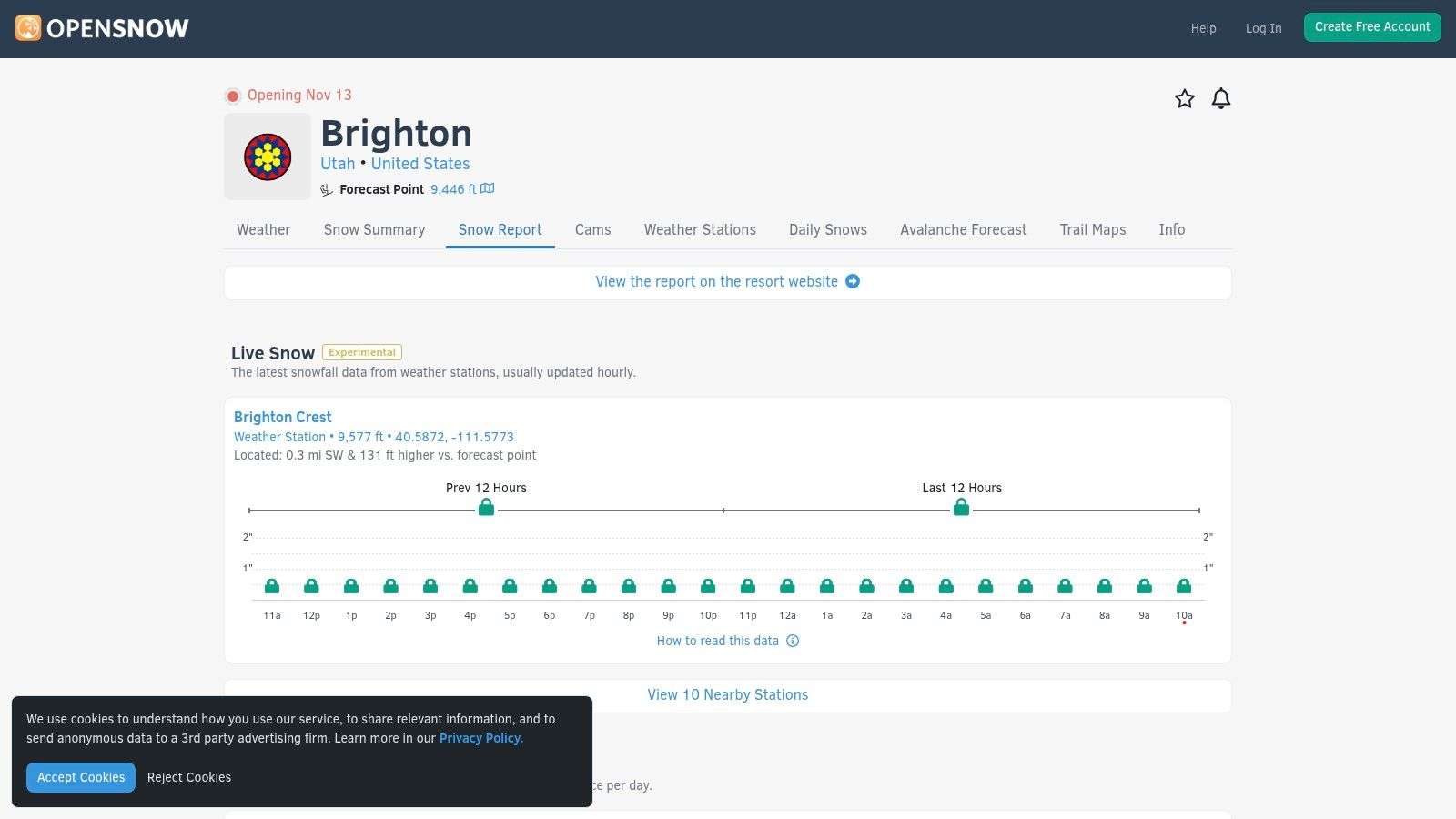
Key Features & How to Use It
- Expert Forecasts: Local forecasters interpret complex weather data, providing daily write-ups that explain storm timing, snow quality, and confidence levels.
- Custom Powder Alerts: Get notified when a significant storm is in the forecast for Brighton.
- Actionable Local Tip: Pay attention to the forecaster's narrative. It often contains clues about snow density (e.g., "drier, colder smoke" vs. "wetter, base-building snow") that can help you decide if it's the right day to go.
Website: https://opensnow.com/location/brighton/snow-report
5. OnTheSnow
OnTheSnow blends official resort-reported data with user reports and historical context, offering a well-rounded snapshot of conditions. Its strength lies in its historical data, which allows you to see past snowfall by month. This makes it an excellent resource for planning future trips based on typical conditions for a specific time of year.
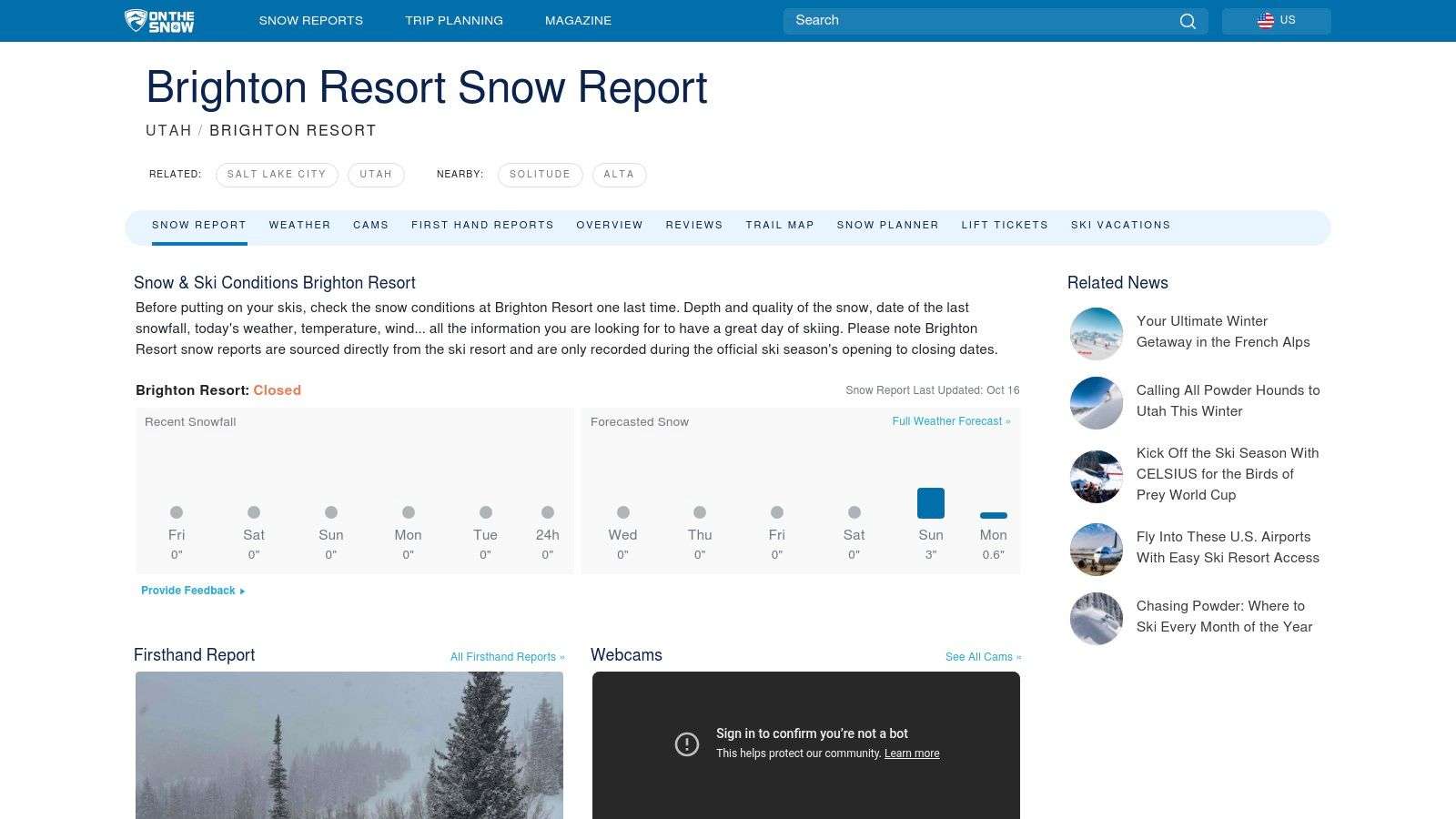
Key Features & How to Use It
- Historical Snowfall Data: Easily view charts of past snow accumulation to understand seasonal trends.
- Community Reports: User-submitted photos and comments can provide a helpful layer of "social proof" beyond the official numbers.
- Actionable Local Tip: Use the "Snowfall History" grid to compare the current season's base depth against the average. This helps manage expectations, especially during early or late season.
Website: https://www.onthesnow.com/utah/brighton-resort/skireport
6. Snow-Forecast.com
For data-driven skiers, Snow-Forecast.com offers a highly detailed, multi-day forecast broken down by elevation (base, mid-mountain, and summit). This is crucial for understanding how temperature and wind will affect snow quality across different parts of the resort. It helps answer the question, "Will the snow be good at the top but wet at the bottom?"

Key Features & How to Use It
- Elevation-Specific Forecasts: Get different predictions for temperature and snowfall at various altitudes on the mountain.
- Detailed Charts: Meteograms, wind charts, and freezing-level maps help you anticipate conditions with precision.
- Actionable Local Tip: Check the freezing level chart before a storm. If the line is high, expect heavier, wetter snow. If it's low, you're more likely to get light, fluffy powder. This pairs well with a broader Wasatch snow forecast.
Website: https://www.snow-forecast.com/resorts/Brighton-Resort/snow-report
7. NOAA / National Weather Service (Point Forecast)
For the most scientifically rigorous and unbiased weather data, the National Oceanic and Atmospheric Administration (NOAA) point forecast is unparalleled. It provides direct access to the raw forecast data used by meteorologists, including detailed hourly tables for temperature, wind, and snow accumulation. It is the best source for an unvarnished, data-rich look at the weather.
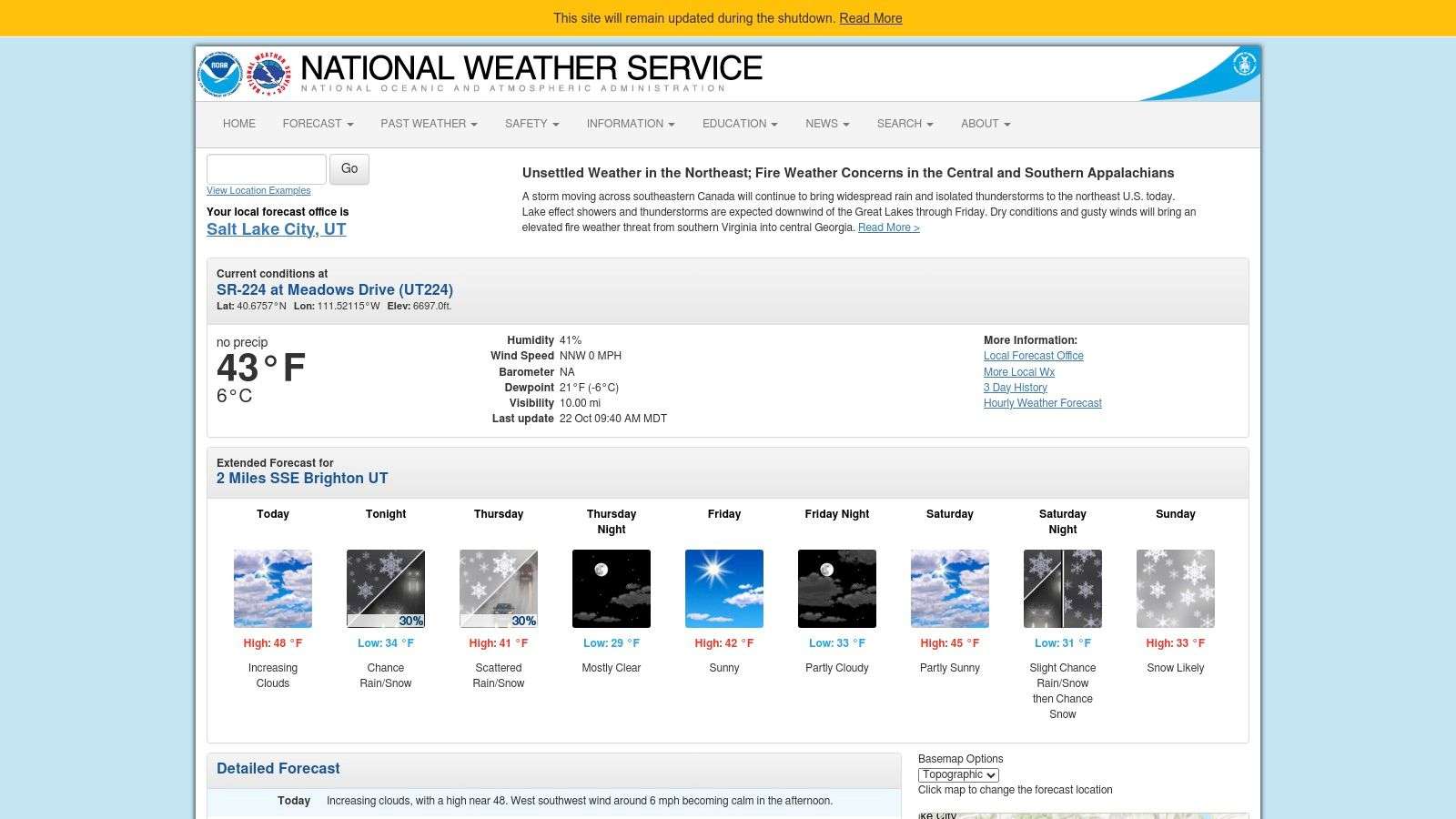
Key Features & How to Use It
- Authoritative Data: This is the source data that many other weather apps are built on.
- Forecast Discussion: Meteorologists provide a text-based explanation of the forecast, offering valuable insight into their confidence and the reasoning behind predictions.
- Actionable Local Tip: Use the hourly weather graph to visually pinpoint when a cold front will arrive or when winds will peak. This is great for timing your runs to avoid a wind hold or catch the first flakes of a storm.
Website: https://forecast.weather.gov/MapClick.php?lat=40.58218&lon=-111.57225
8. Utah Avalanche Center (UAC)
For anyone considering skiing in the sidecountry or backcountry terrain accessible from Brighton, checking the Utah Avalanche Center forecast is non-negotiable. It provides the official daily avalanche danger rating and details on specific snowpack problems. This is not a resort snow report; it is a critical life-saving tool for off-piste travel.

Key Features & How to Use It
- Daily Danger Ratings: The "danger rose" provides a quick visual summary of the risk by aspect and elevation.
- Expert Analysis: Local experts provide a detailed discussion of current avalanche problems (e.g., wind slabs, persistent weak layers).
- Actionable Local Tip: Always read the full "Forecaster Discussion." It provides critical nuance that the danger rating alone cannot convey, such as which specific terrain features are most hazardous.
Website: https://utahavalanchecenter.org/forecast/salt-lake
9. NRCS Utah Snow Survey (SNOTEL)
The NRCS SNOTEL site provides objective, scientific data from an automated weather station located at Brighton. It offers an unfiltered look at snow depth and Snow Water Equivalent (SWE), which is the amount of water contained in the snowpack. This is the raw data forecasters use and is perfect for cutting through marketing hype.
Key Features & How to Use It
- Objective Data: SNOTEL provides measured, ground-truth data on snow depth and water content.
- Historical Context: Its charts compare the current season to the 30-year median, answering the question, "How does this snow year compare to average?"
- Actionable Local Tip: Bookmark the chart for the "Brighton" SNOTEL station. After a big storm, compare the increase in snow depth here to what the resort reports. It's the most objective way to verify snowfall totals.
Website: https://www.nrcs.usda.gov/utah/snow-survey
10. The Weather Channel (Weather.com)
The Weather Channel is a familiar, accessible, and quick general-purpose tool. While not a ski-specific resource, its hourly forecast for the Brighton area is useful for timing your day. It clearly shows when precipitation is expected to start and stop, along with shifts in temperature and wind.
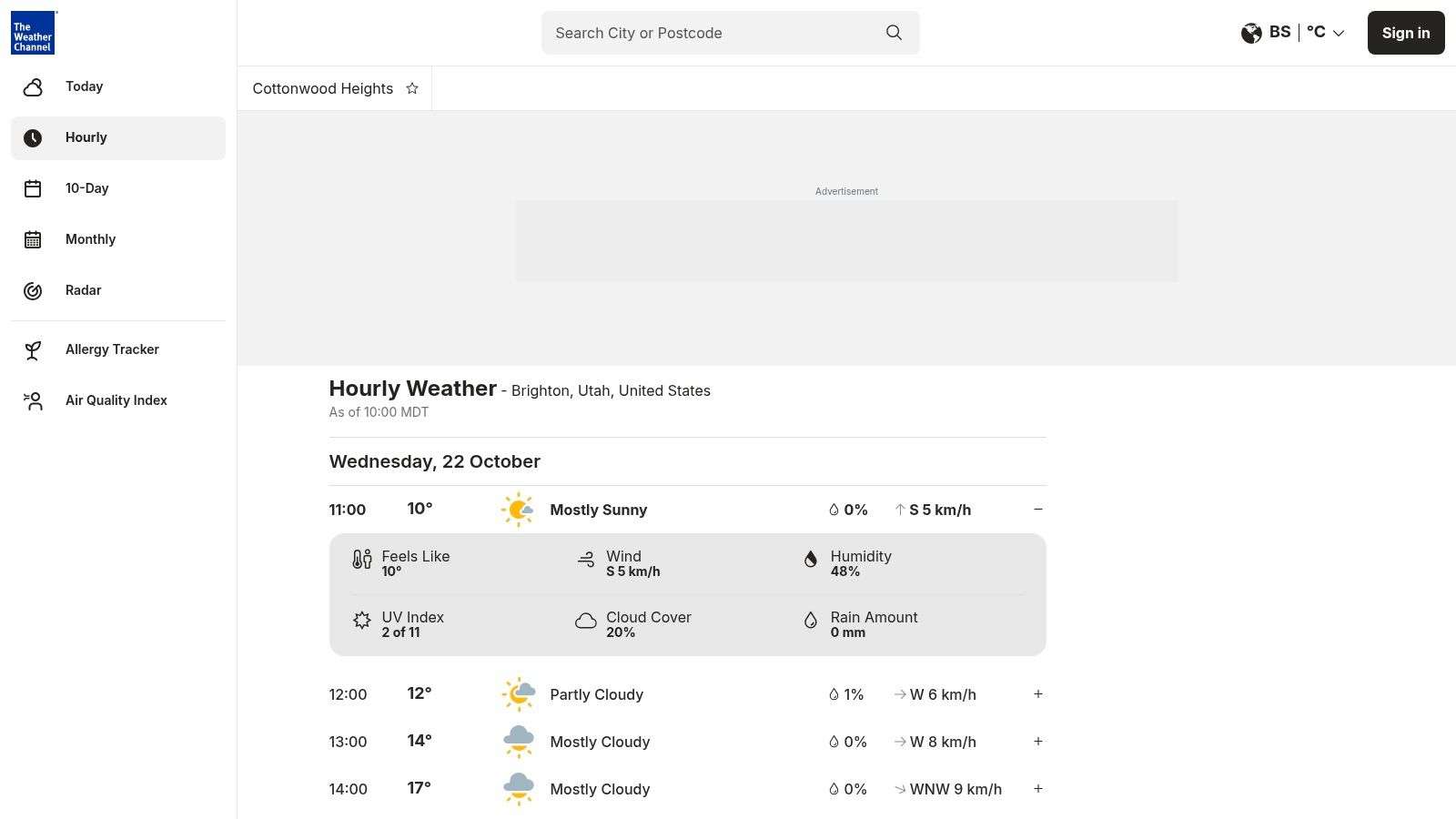
Key Features & How to Use It
- User-Friendly Interface: The hourly view is easy to read at a glance on mobile.
- General Timing: It's great for quick logistical planning, like deciding the best window to drive up the canyon.
- Actionable Local Tip: Use the hourly view to identify the best time for a lunch break—for example, during a period of forecasted high winds or heavy, wet snowfall.
Website: https://weather.com/en-BS/weather/hourbyhour/l/Brighton%2BSki%2BResort%2BUT%2BUSUT0028%3A1%3AUS
11. meteoblue
Meteoblue offers a powerful toolkit for those who want to analyze raw weather model data. It specializes in detailed meteograms and multi-model visualizations, which are excellent for understanding factors like freezing levels and wind at different altitudes. It's a great "second opinion" to cross-reference with other forecasts.

Key Features & How to Use It
- Detailed Visualizations: Its meteograms provide an in-depth, hour-by-hour breakdown of the forecast.
- Multi-Model Data: Ensemble summaries show the range of possible outcomes from different weather models, giving you a sense of forecast certainty.
- Actionable Local Tip: If OpenSnow and NOAA have slightly different forecasts, check the meteoblue ensemble. If most models agree, you can have higher confidence in the prediction.
Website: https://www.meteoblue.com/en/weather/week/brighton_united-states_5414941
12. SnowStash
For a quick, visual-first check, SnowStash consolidates all of Brighton's webcams into one mobile-friendly view. It's the perfect tool for a last-minute visual confirmation of snowfall, visibility, and even crowd levels before you commit to the drive. It answers the simple question: "What does it look like up there right now?"
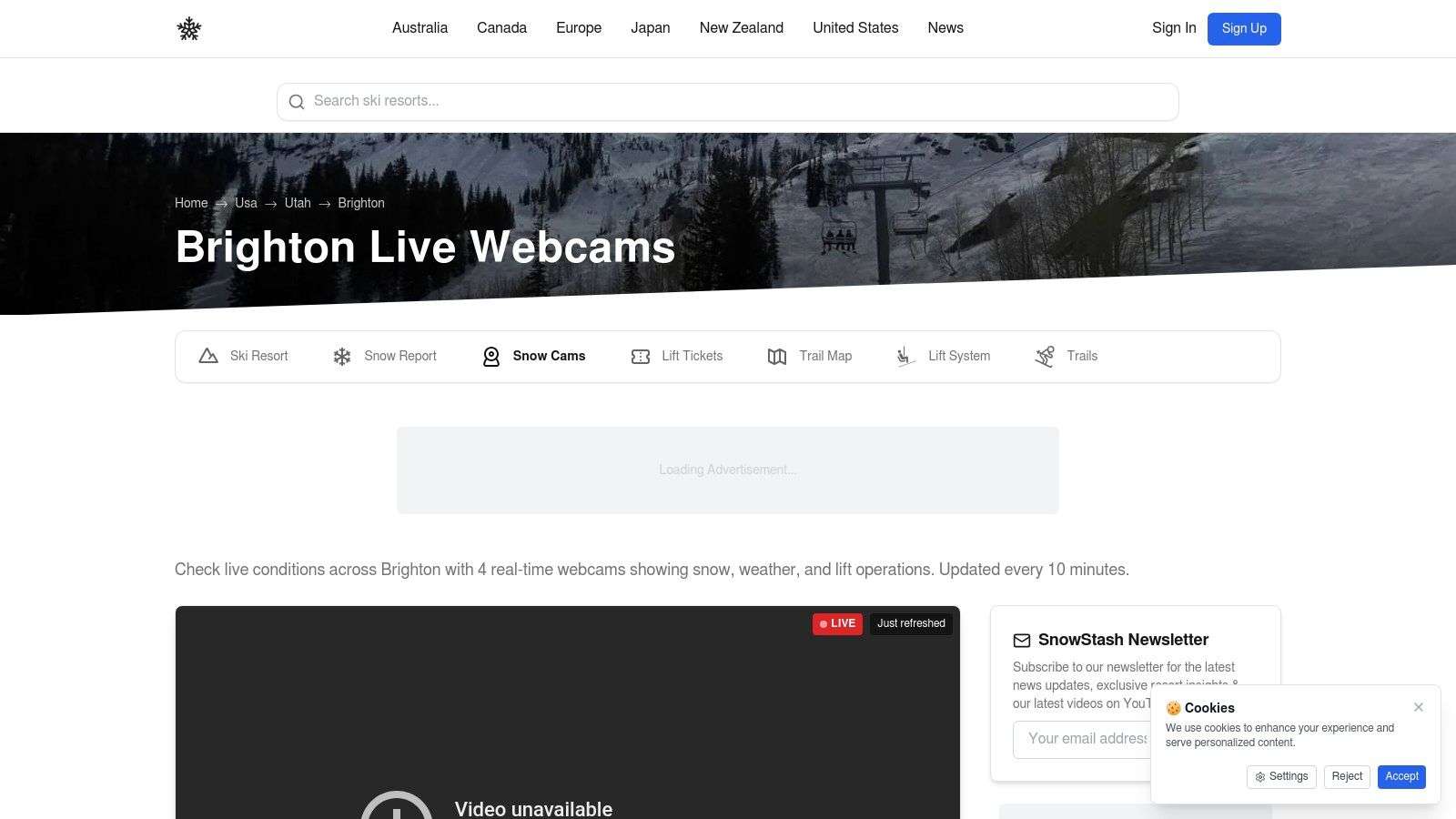
Key Features & How to Use It
- Consolidated Webcams: See all the key camera feeds on a single page instead of clicking around the resort site.
- Real-Time Visuals: Gauge snow quality (is it blowing around or sticking?), visibility, and how busy the base area is.
- Actionable Local Tip: Check the parking lot cams on SnowStash just before you leave. It’s the fastest way to see if the main lots are already full.
Website: https://snowstash.com/usa/utah/brighton-mountain-resort/snow-cams
How to create your own Brighton snow report checklist
A perfect day at Brighton doesn't happen by chance; it comes from having the right information. The key isn't to use every tool every day, but to build a simple, reliable system.
- 3-5 Days Out (Planning): Use OpenSnow to identify potential storms. See if a big system is developing so you can plan your week.
- The Night Before (Fine-Tuning): Check the NOAA Point Forecast for an hour-by-hour breakdown of temperature and snowfall. This helps you decide what to wear and when to leave.
- The Morning Of (Final Go/No-Go): This is your mission-critical check.
- Step 1: Check the Brighton Resort official site to confirm lifts are spinning.
- Step 2: Look at Wasatch Travel Helper for live road conditions, traction laws, and parking status.
- Step 3 (If applicable): Read the Utah Avalanche Center forecast if you plan to access any out-of-bounds terrain.
By layering data from a trusted forecast, the official resort feed, and a real-time travel tool like Wasatch Travel Helper, you move from hoping for a good day to planning for a great one.
Ready to streamline your morning routine? The Wasatch Travel Helper consolidates live road data, traction law alerts, and resort-specific updates into one simple dashboard. Stop jumping between multiple websites and get a clear, actionable picture of your trip to Brighton by visiting Wasatch Travel Helper before you head up the canyon.